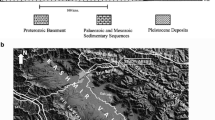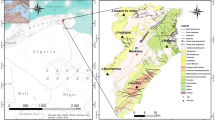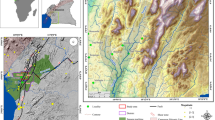Abstract
The most active tectonic areas based on morphotectonic indices is the main aim of this study, are characterized. Mechanical deformation resulting mostly from the Arabia-Eurasia collision is amalgamated by the Alborz Mountains in the form of folding and faulting. The proposed area includes the Alborz province in northern Iran as part of the Alborz mountain range that has seismogenic faults and large earthquakes. Therefore, the basins’ morphologies and shapes are associated with tectonic activity. In this study, the morphometric indices of valley height-width (Vf), asymmetry factor (Af), basin shape (Bs), topographic symmetry factor (T), hypersonic curve (Hc), hypersonic integral (Hi), and river sinuosity (S) were measured for the 33 number basins to assess tectonic activity. Using indices of related active tectonics (IRAT) and weighting and combining morphometric indices, a map was prepared that showed an eye-shaped area at the center of the study area (Hashtgerd) that had high tectonic activity. The tectonic setting survey specified a crush zone because of the collision of active faults near Hashtgerd. A comparison of field observations clearly indicated that the highly active eye-shaped area had a good correlation with the crushed zone and hypocenter of large earthquakes.
















Similar content being viewed by others
REFERENCES
A. Azor, E. A. Keller, and R. S. Yeats, “Geomorphic indicators of active fold growth: South Mountain-Oak Ridge Ventura basin, southern California,” Geol. Soc. Am. Bull. 114, 745–753 (2002).
D. Bachmanov, V. G. Trifonov, K. Hessami, A. Kozhurin, T. P. Ivanova, E. Rogozhin, M. C. Hademi, and F. Jamali, “Active faults in the Zagros and Central Iran,” Tectonophysics 380, 221‒241 (2004).
M. Berberian, Preliminary Report on the Structural Analysis of Ipak Active Fault, Vol. 130 of Geol. Surv. Iran, Rep. (1971).
M. Berberian, Earthquake and Coseismic Surface Faulting on the Iranian Plateau: A Historical, Social, and Physical Approach (Elsevier, New York, 2014).
M. Berberian and G. C. P. King, “Towards a paleogeography and tectonic evolution of Iran,” J. Earth Sci. 18, 1764‒1766 (1981).
M. Berberian, M. Qorashi, B. Arzhang-Ravesh, and A. Mohajer-Ashjai, “Recent tectonics, seismotectonics and earthquake-fault hazard investigation in the Greater Qazvin region,” in Contribution to the Seismotectonics of Iran (Geol. Surv. Iran, Tehran, 1983).
W. B. Bull, Geomorphic Tectonic Classes of the South Front of the San Gabriel Mountain, U.S. Geol. Surv. Contract. Rep. 14-08-001-G-394 (Off. Earthquakes, Volcanoes Eng., Menlo Park, Calif., 1978).
W. B. Bull and L. D. Mcfadden, “Tectonic geomorphology north and south of the Garlock fault, California,” in Geomorphology in Arid Regions: Proceedings of the 8th Annual Geomorphology Symposium, Binghamton, N.Y., 1984, Ed. by D. O. Doehring (State Univ. New York, Binghamton, USA,1977), pp. 118‒138.
P. J. Cannon, “Generation of explicit parameters for a quantitative geomorphic study of Mill Creek drainage basin,” Okla. Geol. Notes. 36 (1), 3‒16 (1976).
R. J. Chorley and L. S. D. Morley, “A simplified approximation for the hypsometric,” Integral. J. Geol. 67, 566‒571 (1959).
R. T. Cox, “Analysis of drainage basin symmetry as a rapid technique to identify areas of possible Quaternary tilt-block tectonics: An example from the Mississippi Embayment,” Geol. Soc. Am. Bull. 106, 571‒581 (1994).
R. T. Cox, R. B. Van Arsdale, and J. B. Harris, “Identification of possible Quaternary deformation in the northern Mississippi embayment using quantitative geomorphic analysis of drainage–basin asymmetry,” GSA Bull. 113, 615–624 (2001).
H. Daxberger, R. Dalumpines, D. Scott, and U. Riller, “The ValleyMorph Tool: An automated extraction tool for transverse topographic symmetry (T-) factor and valley width to valley height (Vf-) ratio,” Comput. Geosci. 70, 154‒163 (2014).
J. Dellenbachs, PhD Thesis (Strasbourg, 1964).
R. El Hamdouni, C. Irigaray, T. Fernández, J. Chacón, and E. A. Keller, “Assessment of relative active tectonics, southwest border of the Sierra Nevada (southern Spain),” Geomorphology 96, 150‒173 (2008).
S. Haerifard, H. Jarahi, M. Pourkermani, and M. Almasian, “Seismic hazard assessment at Esfaraen‒Bojnurd railway, North‒East of Iran,” Geotectonics 52, 151‒156 (2018).
M. Haqiqat, M. Javaheri Tafti, and H. Jarahi, “Seismic hazard assessment and finding the effective fault at Shiraz Area using seismic hazard deaggregation method,” The 21st Symposium of the Geological Society of Iran, Qom, Iran,2018, pp. 8‒18.
M. Honarvar, H. Jarahi, and M. Nadalian, “Seismic hazard macrozonation in Karaj area,” National Conference in Applied Civil Engineering and New Achievements, Karaj, Iran,2014, pp. 19‒26.
J. E. Hurtrez and F. Lucazeau, “Effect of drainage area on hypsometry from an analysis of small-scale drainage basins in the Siwalik hills (Central Nepal),” Earth Surf. Processes Landforms 24, 799–808 (1999).
J. Jackson, K. Priestley, M. Allen, and M. Berberian, “Active tectonics of the South Caspian Basin,” Geophys. J. Int. 148, 214‒245 (2002).
H. Jarahi, MS Thesis (Tehran, 2011).
H. Jarahi, “Ground-motion scenarios consistent with probabilistic seismic hazard deaggregation for Karaj city (Iran),” Am. J. Eng. Appl. Sci. 9, 520‒529 (2016).
H. Jarahi, “Damavand earthquake of 2020, The mainshock or an alarm for disaster for Capital of Iran,” Earth Sci. Res. J. 25 (1), 23‒32 (2020).
H. Jarahi, “Delineate location of the last earthquake case study NW of Iran,” Current Res. Geosci. 7 (1), 7‒13 (2017).
H. Jarahi, Geohazard Analysis Modern Methodology of Seismic, Landslide, and Liquefaction Hazard Macrozonation of Iran (Samt Publ., Tehran, 2019).
H. Jarahi, “Paleo-mega lake evidence and its effect on civilizations taking place case study, SE Tehran,” Interantional Symposium of the Near Eastern Landscape Archaeology, Istanbul, Turkey,2019, p. 14.
H. Jarahi, N. Naraghiaraghi, and M. Nadalian, “Short period spectral acceleration zonation of Tehran a comparison between slip and activity rates data’s,” Current. Res. Geosci. 6 (1), 36‒46 (2016).
E. A. Keller and N. Pinter, Active Tectonics: Earthquakes, Uplift, and Landscape (Prentice-Hall, Upper Saddle River, N.J., 2002).
P. Molin, F. J. Pazzaglia, and F. Dramis, “Geomorphic expression of active tectonics in a rapidly-deforming forearc, Sila massif, Calabria, Southern Italy,” Am. J. Sci. 304, 559–589 (2004).
J. E. Muller, “An introduction to the hydraulic and topographic sinuosity indexes,” Ann. Assoc. Am. Geograph. 58, 371‒385 (1968).
R. J. Pike and S. E. Wilson, “Elevation–relief ratio, hypsometric integral and geomorphic area-altitude analysis,” GSA Bull. 82, 1079–1084 (1971).
M. Pourkermani, I. Golabatunchi, N. Ahmadi Comijany, and H. Jarahi, “Seismic hazard assessment in site of Behjatabad Dam, Abyek Qazvin area,” 7th Symposyum of Engineering Geology and Existence, Shahrood, Iran,2012 (Shahrood Ind. Univ., 2012), p. 6.
M. Ramírez-Herrera, “Geomorphic assessment of active tectonics in the Acambay Graben, Mexican volcanic belt,” Earth Surf. Processes Landforms 23, 317–332 (1998).
T. K. Rockwell, E. A. Keller, and D. L. Johnson, “Tectonic geomorphology of alluvial fans and mountain fronts near Ventura, California,” in Tectonic Geomorphology: Proceedings of the 15th Annual Binghamton Geomorphology Symposium, Binghamton, N.Y.,1984, Ed. by M. Morisawa and J. T. Hack (Allen & Unwin, Boston, 1985), pp.183–207.
S. A. Schumm, “Evolution of drainage systems and slopes in badlands at Perth Amboy, New Jersey,” GSA Bull. 67, 597–646 (1956).
A. N. Strahler, “Hypsometric (area-altitude) analysis of erosional topography,” GSA Bull. 63, 1117‒1142 (1952).
A. N. Strahler, “Quantitative geomorphology of drainage basins and channel networks,” in Handbook of Applied Hydrology, Ed. by V. T. Chow (McGraw-Hill, New York, 1964), pp. 439‒476.
J. S. Tchalenko, M. Berberian, H. Iranmanesh, M. Baily, and M. Arsovsky, “Tectonic framework of the Tehran region,” in Contribution to the Seimsotecotnics of Iran, Vol. 29 of Geol. Surv. Iran Rep. (1974), pp. 7‒46.
I. M. Tsodoulos, I. K. Koukouvelas, and S. Pavlides, “Tectonic geomorphology of the easternmost extension of the Gulf of Corinth (Beotia, Central Greece),” Tectonophysics 453, 211‒232 (2008).
W. Viveen, R. T. van Balen, J. M. Schoorl, A. Veldkamp, A. J. A. M. Temme, and J. R. Vidal-Romani, “Assessment of recent tectonic activity on the NW Iberian Atlantic Margin by means of geomorphic indices and field studies of the lower Miño River terraces,” Tectonophysics 544‒545, 13‒30 (2012).
A. Zamanfashami, M. Nadalian, and H. Jarahi, “Determine the controlling earthquake by deaggregation method in Behjatabad Dam,” J. Sci. 22 (85), 87‒99 (2012).
F. Zhi-Ping, H. Guo-Fen, and X. Si-Han, “A method for multiple attribute decision-making with the fuzzy preference relation on alternatives,” Comput. Ind. Eng. 46, 321–327 (2004).
ArcGIS software, An overview of the Analysis toolbox in ArcMap 10.3. https://desktop.arcgis.com/en/a-rcmap/ 10.3/tools/analysis-toolbox/an-overview-of-the-analysis-toolbox.htm. Accessed May 23, 2019.
ACKNOWLEDGMENTS
The authors are sincere grateful to reviewers Prof. V.G. Trifonov and Prof. A.I. Kozhurin (both at the Geological Institute, Russian Academy of Sciences, Moscow, Russia) for their useful comment that allowed us to improve our manuscript.
Author information
Authors and Affiliations
Corresponding author
Additional information
Reviewers: V.G. Trifonov, A.I. Kozhurin
Rights and permissions
About this article
Cite this article
Taesiri, V., Pourkermani, M., Sorbi, A. et al. Morphotectonics of Alborz Province (Iran): A Case Study Using GIS Method. Geotecton. 54, 691–704 (2020). https://doi.org/10.1134/S001685212005009X
Received:
Revised:
Accepted:
Published:
Issue Date:
DOI: https://doi.org/10.1134/S001685212005009X




